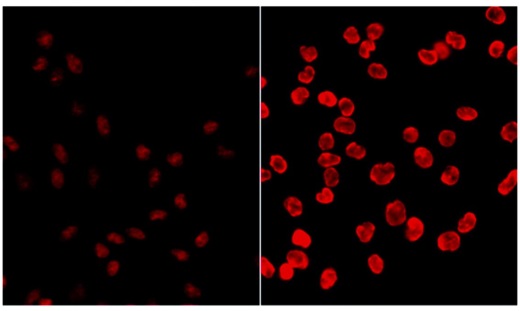All-Clear for Nonlinear Optical Imaging

In the field of biomedical imaging, nonlinear optical (NLO) imaging is gaining importance for applications such as visualizing collagen, elastin and cellular metabolic activity. The nonlinear processes needed for NLO imaging like multi-photon excitation (MPE) and second harmonic generation (SHG), require an extremely high concentration of NIR photons to excite biological fluorophores.
While conventional lasers could lead to overheating and tissue destruction, femto-second (fs) pulsed lasers conveniently provide the high photon fluxes. The harmful effects are restricted to the irradiated tissue and do not have long term effects. Yet, studies have shown that MPE processes can form UV photoproducts from DNA such as cyclobutane pyrimidine dimers (CPDs) which may eventually lead to carcinogenesis. Thus, how save are NLO biopsies?
To evaluate these safety aspects, a team from Erasmus Medical Centre, Rotterdam and from Utrecht University (The Netherlands) estimated the risk of squamous cell cancer induction in skin following nonlinear optical imaging. First, it had to be considered, that CPDs are routinely produced in human skin by the UV component of sunlight – exposure to sunlight already causes a certain risk for skin carcinogenesis, especially squamous cell carcinoma (SCC). Therefore, the scientists decided not to evaluate an absolute carcinogenic risk due to NLO imaging, but to estimate the relative carcinogenic risk of SCC from NLO imaging above the risk due to regular sunlight exposure.
As a base, they chose an established carcinogenic risk model for humans, which estimates risk from exposure to continuous wave (CW) laser. This model was modified and expanded. Instead of CW UV laser radiation, the cumulative radiation received due to pulsed NIR wavelengths from nonlinear biopsies was considered. The derived model is unique because it assesses the risk of CPD related carcinogenesis due to both 2- and 3-photon effects.
To assess how effective NIR femto-second laser pulses are at inducing carcinogenic DNA lesions, the authors compared the levels of DNA mutations (CPDs) induced in Chinese Hamster Ovary (CHO) cells in vitro by pulsed NIR from NLO imaging with those induced by regular CW UV.
The newly derived risk model indicated that the increase in CPD-induced SCC risk from NLO biopsy is negligible above that from regular exposure to UV radiation in sunlight. The relative risk from 40 or more nonlinear biopsies over is notably higher, but this increase is still lower than the risk arising from sunbathing or having an outdoor profession.
However, it has to be considered that the risk could become significant if the NLO biopsies are performed without discretion, i.e. by using unnecessarily high energy fluence for imaging, performing too many scans over the same tissue site or carrying out excessive NLO biopsies. The authors conclude that it is necessary to delineate an efficient protocol for NLO biopsy in the clinic to ensure its efficacy as a diagnostic tool and also minimize possible long-term effects. (Text contributed by K. Maedefessel-Herrmann)
See the original publication: Giju Thomas, Oleg Nadiarnykh, Johan van Voskuilen, Christopher L. Hoy, Hans C. Gerritsen, and Henricus J. C. M. Sterenborg, Estimating the risk of skin cancer induction following nonlinear optical imaging, J. Biophotonics 7:7, 492-505 (2014); DOI http://onlinelibrary.wiley.com/doi/10.1002/jbio.201200207/pdf
Media Contact
All latest news from the category: Health and Medicine
This subject area encompasses research and studies in the field of human medicine.
Among the wide-ranging list of topics covered here are anesthesiology, anatomy, surgery, human genetics, hygiene and environmental medicine, internal medicine, neurology, pharmacology, physiology, urology and dental medicine.
Newest articles

“Nanostitches” enable lighter and tougher composite materials
In research that may lead to next-generation airplanes and spacecraft, MIT engineers used carbon nanotubes to prevent cracking in multilayered composites. To save on fuel and reduce aircraft emissions, engineers…

Trash to treasure
Researchers turn metal waste into catalyst for hydrogen. Scientists have found a way to transform metal waste into a highly efficient catalyst to make hydrogen from water, a discovery that…

Real-time detection of infectious disease viruses
… by searching for molecular fingerprinting. A research team consisting of Professor Kyoung-Duck Park and Taeyoung Moon and Huitae Joo, PhD candidates, from the Department of Physics at Pohang University…





















